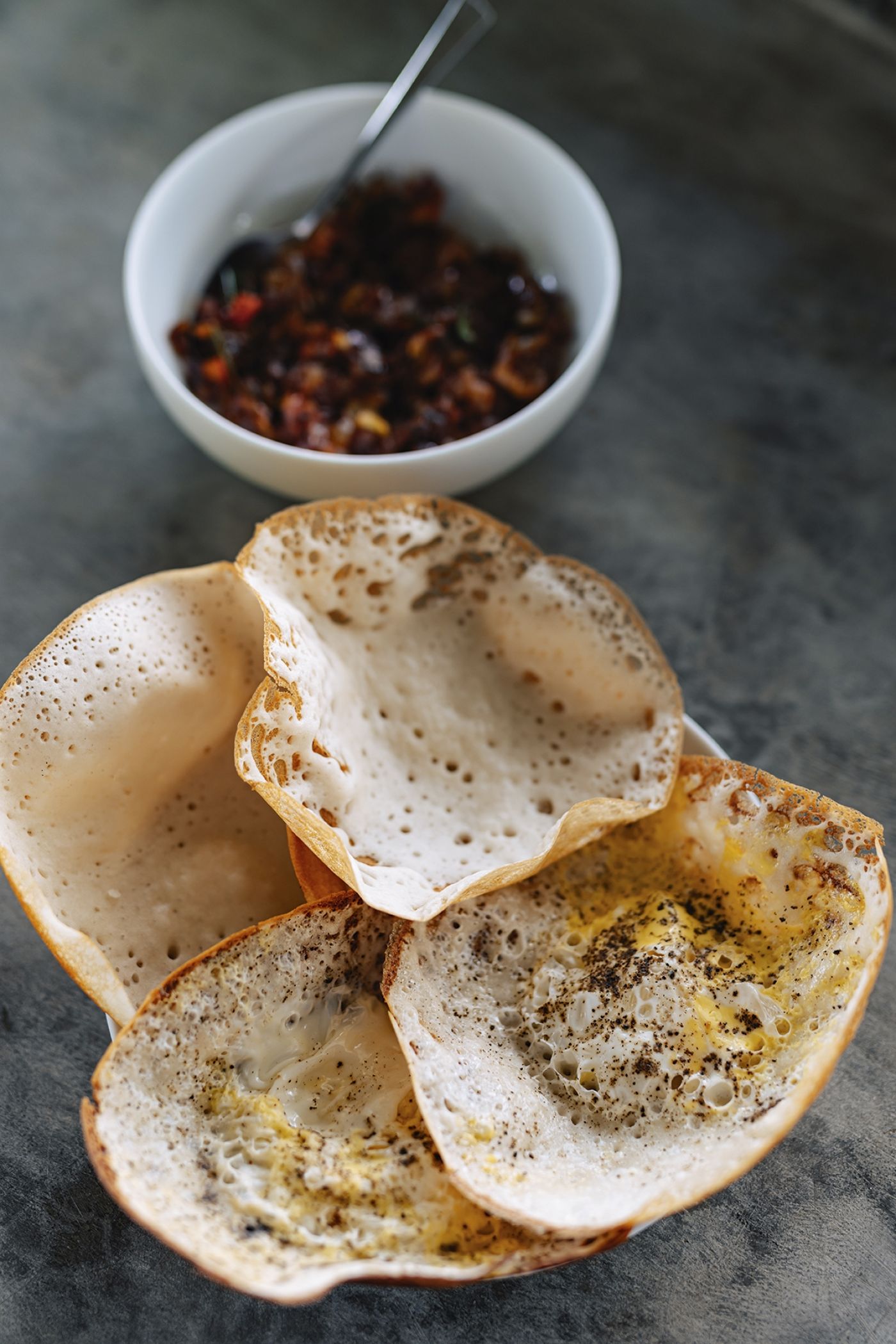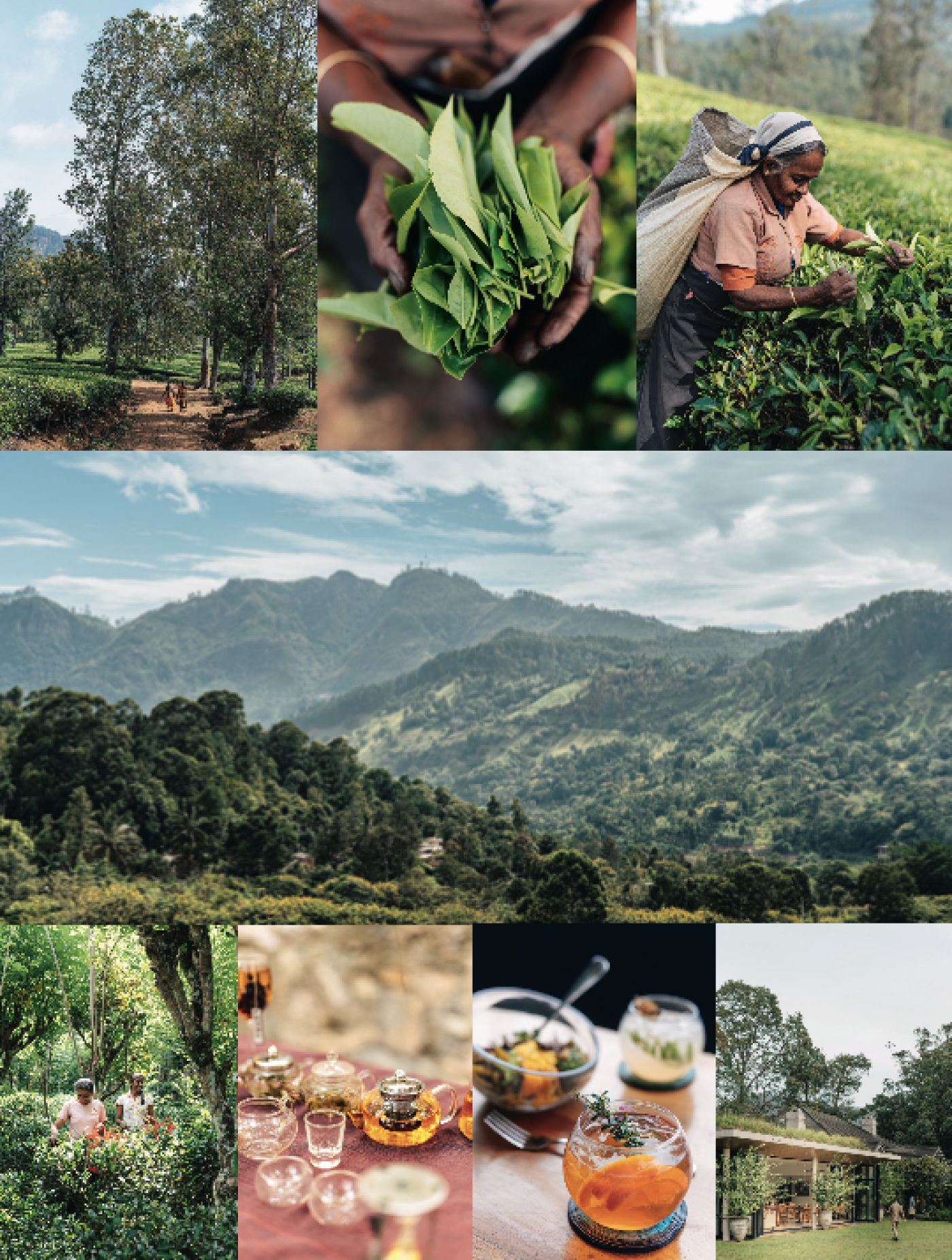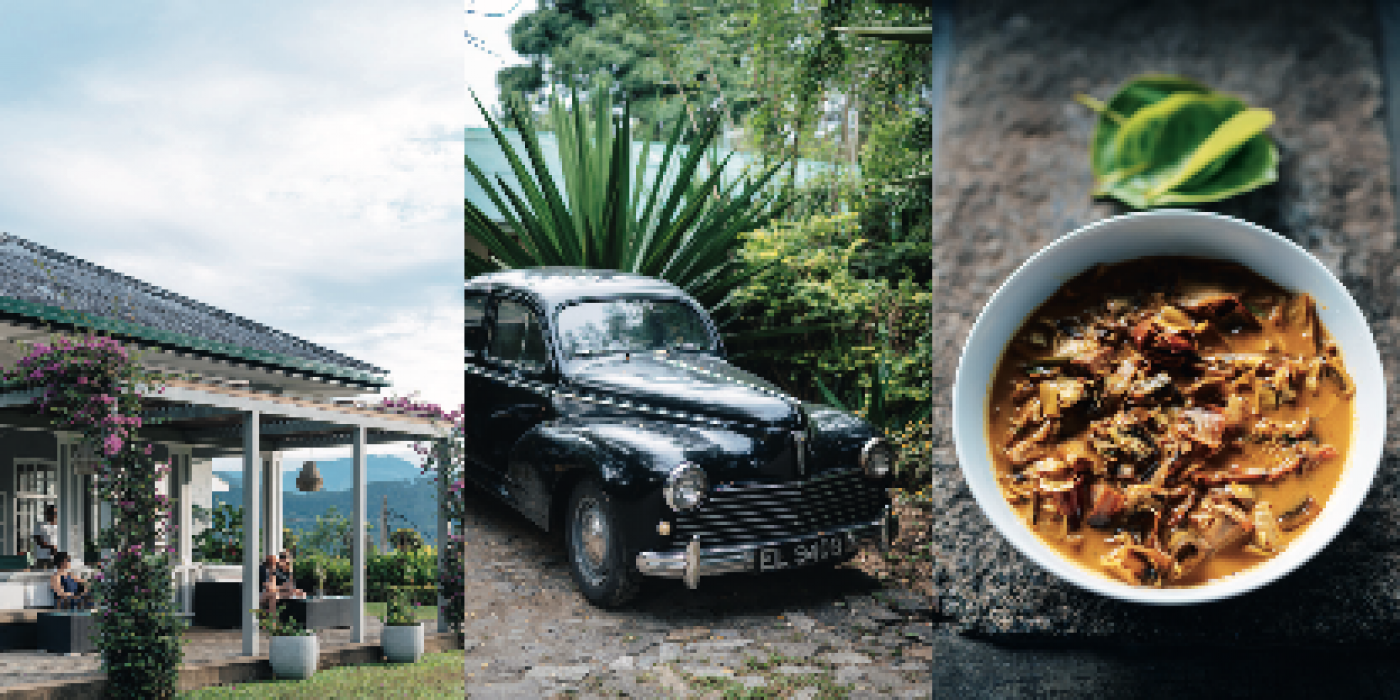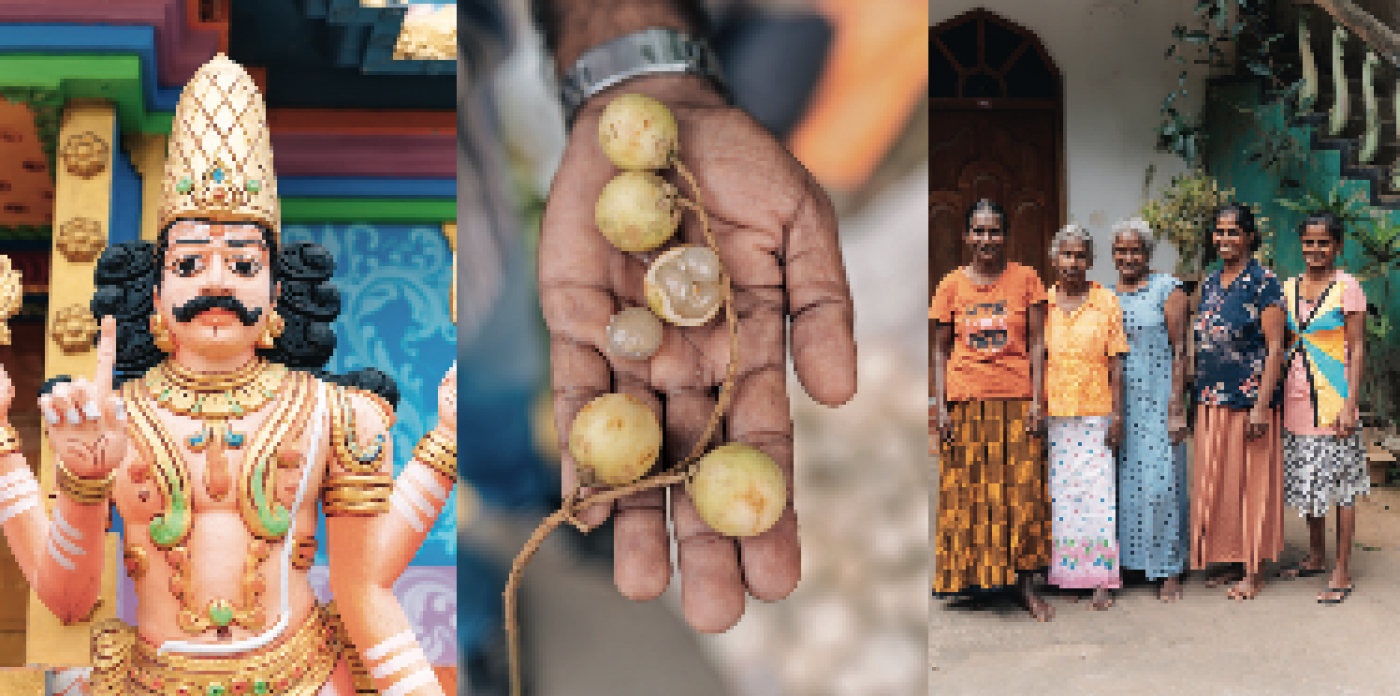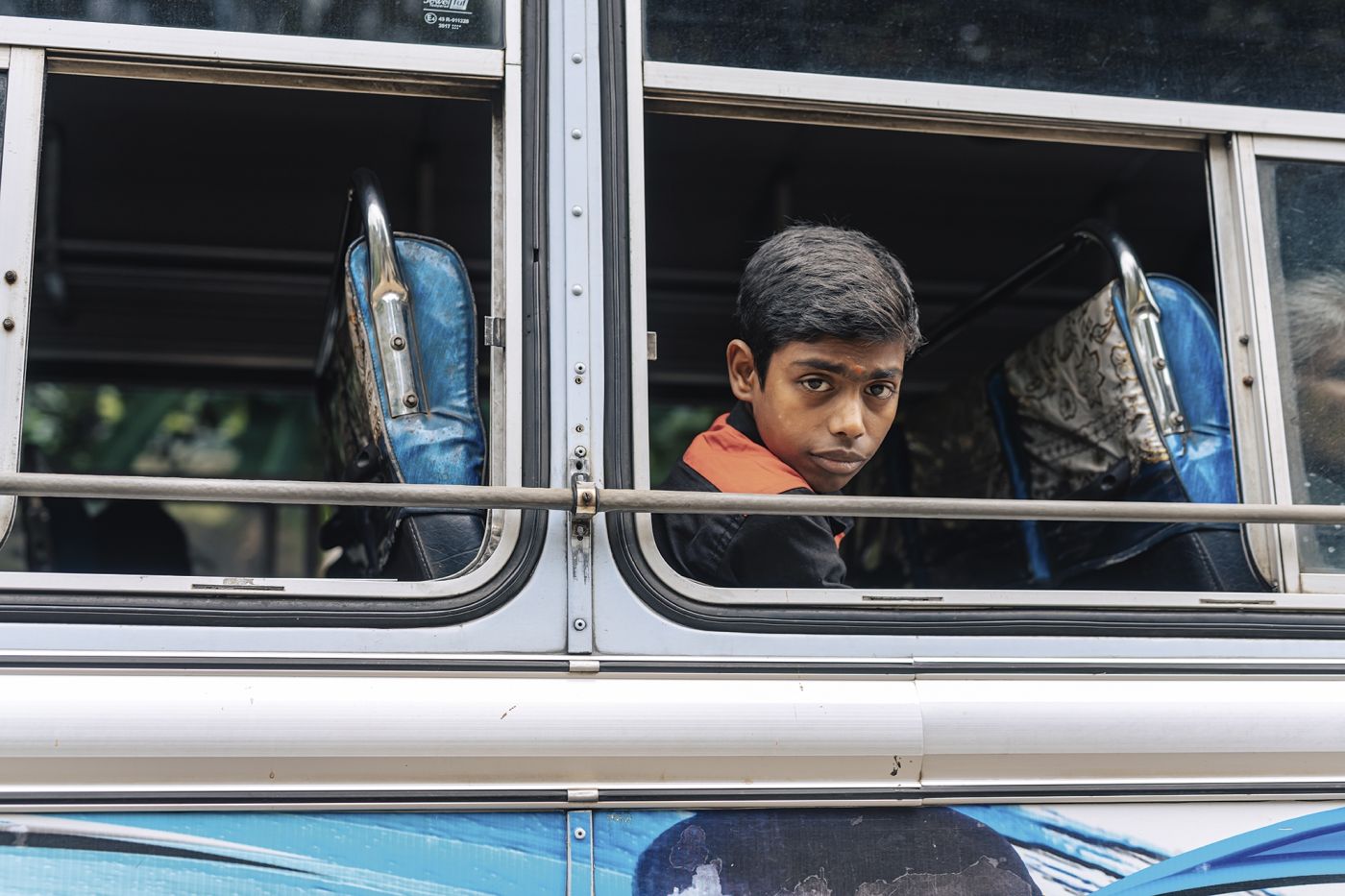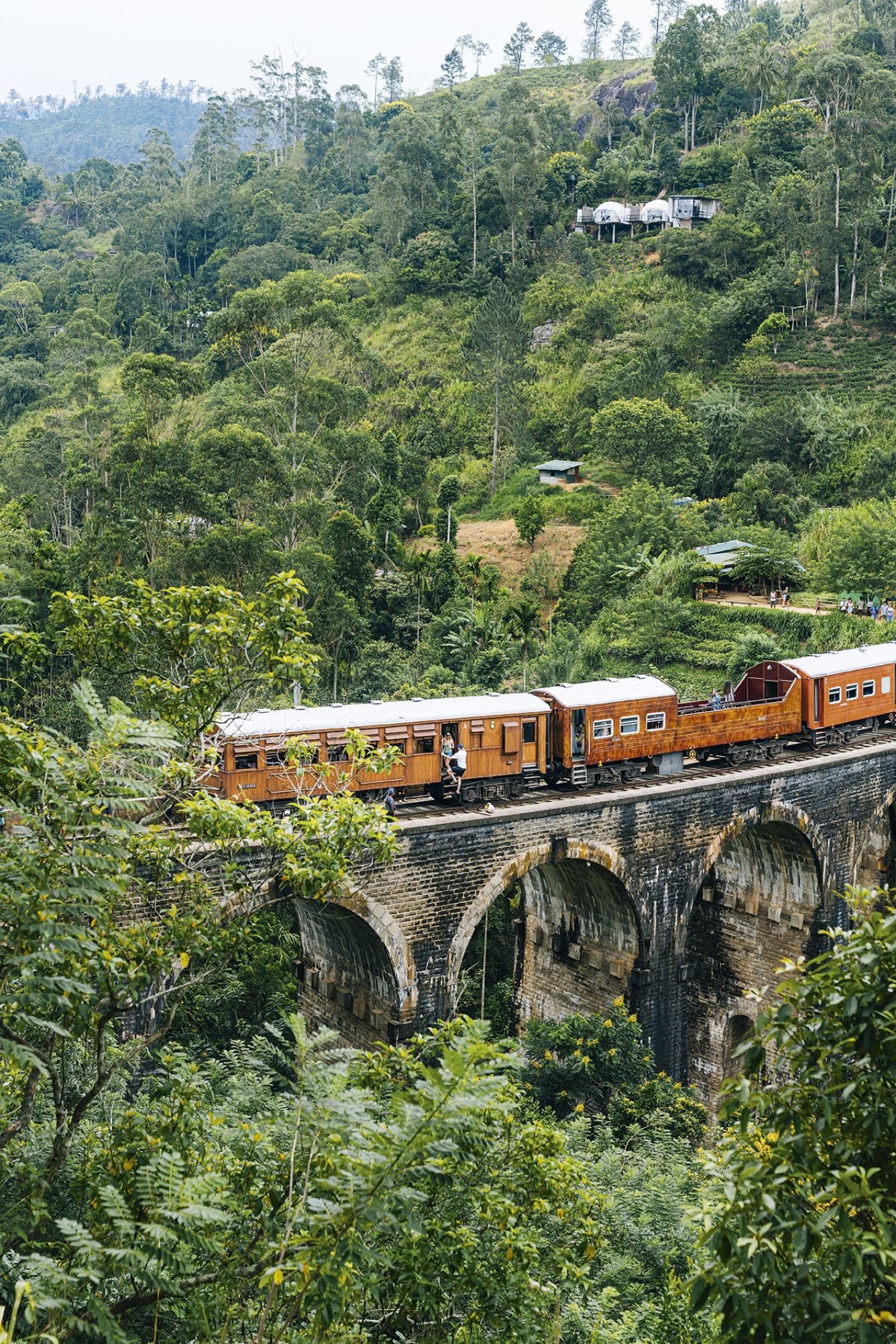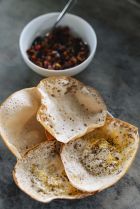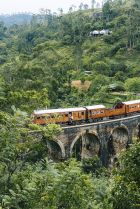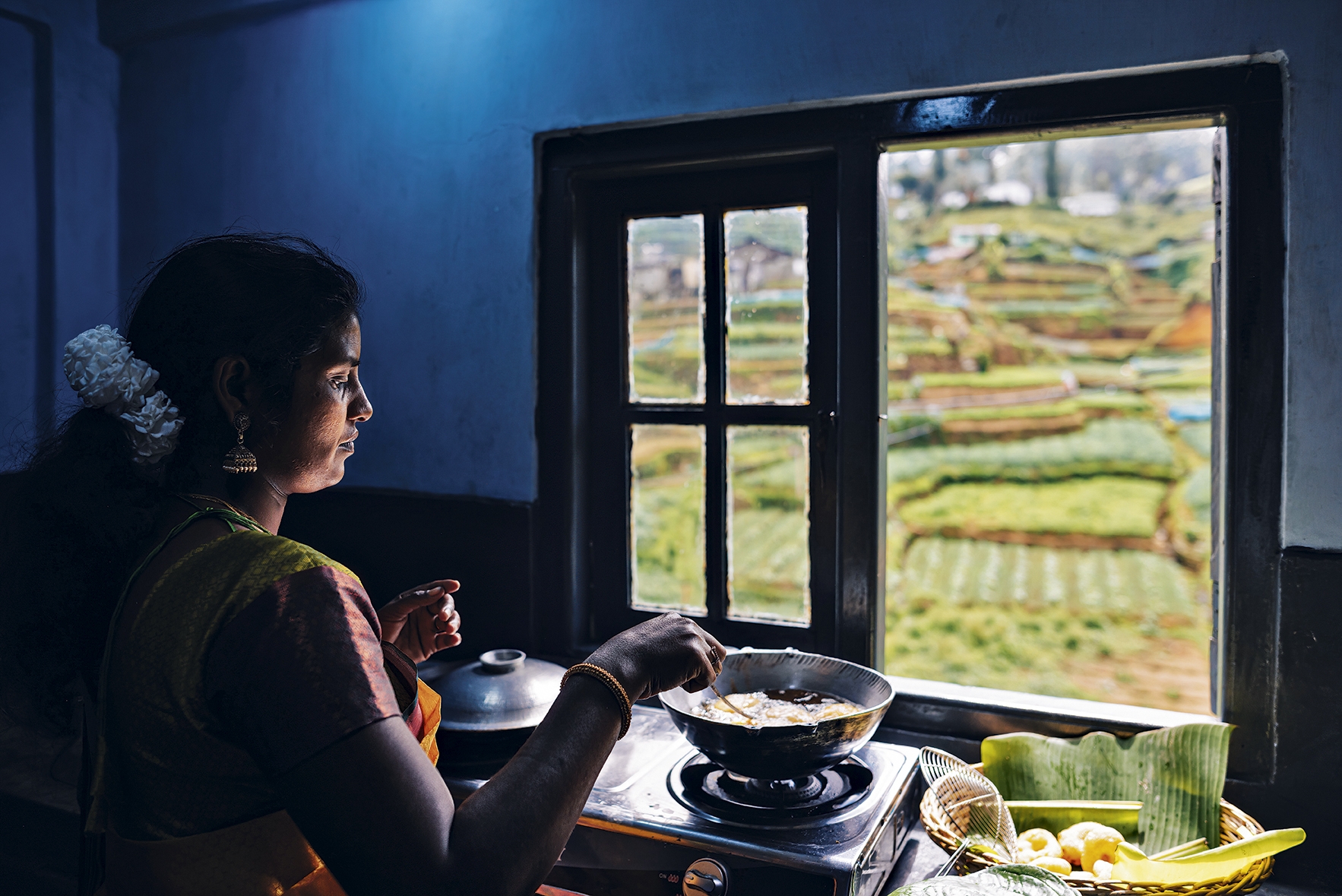
Food and Travel Review
Time is of the perfumed essence in the warm, morning hours at Amba Estate in Sri Lanka. Assistant production manager Ashok wends his way between rambling coffee plants and hoity-toity ranks of carefully clipped tea bushes, accompanied by the whistle of tailorbirds and the delicate trill of a flowerpecker. He’s on a mission to find a great, dangling orchid.
Each day, Ashok is an understudy for a star that never shows up – the miniature melipona bee. Not native to Sri Lanka, it’s the only natural pollinator for this valuable orchid, whose flowers bloom for just 24 hours. Ashok performs his part expertly: he crouches to find a single, white flower among the vine’s mass of rubbery leaves. He peels back star-like sepals to access its intricate, frilled column, and in a deft ballet of velveteen petals and handy toothpick, pollinates it. In nine months, the plant will produce the world’s second-most expensive spice: vanilla.
Vanilla is one of the many crops used in Amba’s award-winning teas. The estate’s Edenic, tea-strewn hillsides are hidden by winding, forested roads littered with insouciant stray dogs and sweeping valleys. Although easily overlooked, their artisanal hand- crafted teas are anything but. Amba supply Noma, Harrods, Fortnum & Mason and Claridge’s, and have stacked up international awards and acclaim for their teas and tisanes.
Under a pergola of saffron-and-scarlet clock vines, Neethanjana Senadheera serves up a glass of hand-rolled vanilla black tea gems. The leafy nests unfurl in a swirl of steaming water, resulting in a perfectly balanced tea of creamy vanilla and soft tannins. In another, he pours a taster of Japanese-style green tea: it’s vegetal and silky, with briny notes that conjure seaweed and salt spray.
Neethanjana is Amba’s tea-maker and production manager; his merry, unguarded demeanour belies a voracious, Wonka-esque talent. A recent client asked for a herbal brew that represented the elements, with a specific colour to boot, and the resulting tisane took six months to accomplish. It’s a perfectly pink concoction of white mulberry, pandan, hibiscus and bell fruit that leaves a wake of sweets and toasted barley as it’s poured.

Amba’s handmade teas are setting a new standard in Sri Lanka – a system overhaul that’s long overdue. ‘A hundred years ago, we were number one. But then we never changed anything, never modified. Whatever the British did, we continued,’ explains Neethanjana. And the undeniable rot at the root of Sri Lanka’s tea production was that the British relied on slavery: usually Tamil tea pickers brought from southern India and shoved into estates to work for food. Whole families lived in tiny rooms (now used for storage at Amba), their names reduced to a door number. Children were merely a conveyor belt of workers: the saying went ‘born by the tea bush, die by the tea bush’.
These tainted connotations have resulted in an ageing picking population with no one taking their place. Unfortunately, tea is a finicky crop: it has to be picked by hand to get the best flavour, as machines don’t have the dexterity and discernment of humans. ‘The biggest problem in Sri Lanka is respect and value for the tea picker,’ explains Neethanjana. ’We need to bring them confidence, education and responsibility.’ Born in the local Ambadandegama village, he actually joined Amba as a sociologist and anthropologist, hoping to change the lives of tea pickers. ’Changing humans is the most difficult part in my job. They used to be tea pickers who follow the orders; we want them to think as tea crafters, as artisans.’
Amba’s approach was to reduce yield and profit, but increase responsibility. Every crafter is taught the entire process so they pick, wither and create their own personal tea to be blended into Amba’s brew. In addition, they receive education, are paid higher wages and get bonuses based on a share of company revenues.The results are multifarious, including a 300-strong waiting list of locals applying to work for Amba. Fewer women are now leaving Ambadandegama to find work, which keeps families together and is ultimately changing the village’s future. Equality has increased as men enter the picking workforce – traditionally seen as a ‘low’, female, job. Amba aren’t keeping their elite clientele to themselves, either. They’ve formed a cooperative and are teaching their model to other estates, with the aim of transforming Sri Lankan tea into a modern, socially-responsible business.
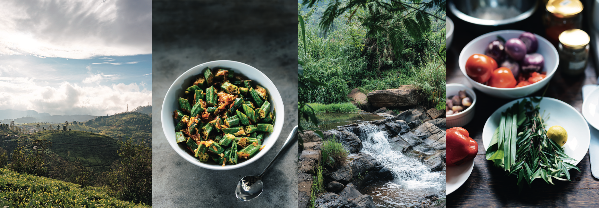
Although every Hill Country local lives alongside tea, not everyone works with it. Along the coiling road from Amba, plastered with pictures of the newly elected president’s youthful, hopeful face, is Wineetha Manathunga’s home cooking school. In a sliver of a kitchen the colour of a pandan cake, five women are busy boiling, grinding, stoking, watching.
Every woman from Wineetha’s family has come to help out, packed in a cupboard-like space that’s licked with heat from the open hearth. The smiling matriarch floats about like a peach-clad deity, entirely deaf but eager-eyed as her recipes are recreated. Surfaces brim with night-sky aubergines, shiny green coconuts, vibrant carrots, green beans, mint, chillies, all from Wineetha’s home farm. She stokes the fire and begins toasting curry leaves, garlic and shallots. On the concrete outside, a sister mattocks a coconut into submission while another begins on sambol.
Sambols are a staple of Sri Lankan cuisine; sometimes called a salad as they’re usually uncooked, they’re like a condiment. Sambols are chock full of chillies, shallots, citrus and garlic and although coconut and onion are the most popular options, Wineetha whips up mint and carrot versions too. The carrot tops them all, full of natural sweetness brightened with zippy citrus. In little time, a feast steams atop a tablecloth embroidered with glittering gold. Alongside rice and sambols, there’s juicy brinjal (aubergine) curry, the finest creamy dhal imaginable, green bean curry with a black pepper base, and fish curry. Made with chunks of dried shark, the fish is spiky and solid, if too salty for the uninitiated palate – but it’s a popular and cheap protein hit in this inland region. The peppered beans are unbeatable, their delightful heat growing dragon-like at the back of the throat, before being tamed by lime and coconut. It’s nowhere near local spice levels; this cooler region is known for its fiery curries, but only roadside buffets seem willing to test Westerners’ mettle.
Below these peaceful, nori-coloured hills sits Ella; a busy thoroughfare of rampant backpackers, ambiguous pavements and buses emblazoned with amusingly inexplicable graphics. Ella’s relatively recent tourist takeover means most restaurants now serve menus of avocado toast, jackfruit burgers and poke bowls.
Rainbow Cafe is one of the oldest establishments in the hilltop town. Beyond the Western menu board, Kalinga and his wife Mazzy are dedicated to showcasing Sri Lankan ingredients. Local Ella lad Kalinga is happiest tinkering away in his kitchen, creating indigenous botanicals or his stunning local coffee liqueur, perfect for ever- popular espresso martinis. His genuinely brilliant baby jack burger easily surpasses the norm; instead of the conventional pulling and smoking, he incorporates local curry leaves and cardamom.
‘They have so many wonderful ingredients in this region,’ explains Mazzy. We’ve got a lot of avocado and jackfruit trees, even in our driveways – you’re tripping over the stuff.’

Therein lies Ella’s strange irony. Those hipster menus that can seem objectionable to cuisine-keen travellers actually use regional ingredients in a sustainable, novel way. Fusion-focused Kalinga has become such an unwitting trendsetter that he continually has to adapt the menu, as neighbouring restaurants purloin his dishes.
Mazzy blames others’ lack of creativity on what she sees as an over-reliance on traditional curry. ‘Whenever I go to my local fruit and veg lady, I ask her to explain what she does with an ingredient and she says “curry”. It’s always curry,’ laughs Mazzy. Yet, after just two days in Sri Lanka, it’s clear the word ‘curry’ is a blanket term for any dish served alongside rice, spattering menus like a Gatling gun: okra curry, chicken curry, beef curry, jackfruit curry, banana flower curry, fish curry – the list goes on. The catch-all word does huge disservice to Sri Lanka’s dishes, which can differ greatly in texture, method and taste.
There’s no doubt, though, that the country is firmly in the grip of curry. Ask what someone’s favourite dish is and the clarion call resounds around the rolling mountains: rice and curry. ‘It’s still the old-fashioned curry for breakfast, lunch and dinner,’ sighs Kalinga. ‘Many of my friends can’t live without it. If they go abroad, they ask for rice and curry. They even bring rice and sambol with them.’
Terminology and local tastes aside, Hill Country’s ingredients are diverse and rich. Ella’s market, spread along the road beside inch- near buses and shiny, beetling tuktuks, is an extraordinary cascade of farmed and foraged produce. There are fresh, creamy cacao pods especially beloved by children; spinachy gotu kola (Asiatic pennywort) and spindly snake beans for curries and salads; stringy wild mangoes that sour spicy dishes; Sri Lanka’s famed king coconuts; and packets of chewing betel, tobacco, areca and lime, which stain many a seller’s blackened gum smile.
It’s a market best explored by tastebud, to occasional detriment. Wrenched open, the resoundingly brown wood apple reveals bletted flesh. The texture is disturbingly overripe, gummy and bristly. Alone, it tastes like soured mulch, but it’s hugely popular in Sri Lankan drinks and smoothies. Far better are two indigenous fruits: the gaduguda and gal siyambala. The latter is known as the pebble tamarind: a grape-sized fruit with a crisp, velvet shell. Cracked apart, the thin layer nibbled off its seed is like a delicacy of sherbert and suede. The gaduguda is inordinately diverting, its hard skin hiding three translucent bubbles of flesh. Alien-like and surprisingly malleable, they burst with flavours of lychee, creamy lime and sweet acidity.
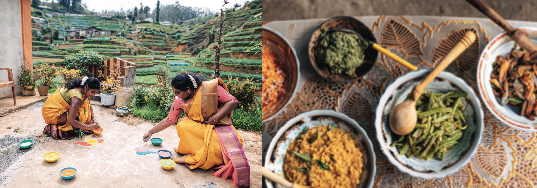
The great trees of both have long freckled this landscape, their fruits used in traditional medicines, but change is coming. The stone tamarind tree now faces extinction from deforestation and heavy-handed harvesting – just some of the many problems that are facing native crops today.
West towards Nuwara Eliya, the scenery climbs and morphs. Raggedy, rust-tinged cinnamon trees and iridescent gangs of peacocks give way to fountains of ehela (golden shower trees) and forests of ash-grey eucalyptus with strips of bark hanging like witches’ fingers. The glossy legions of tea remain – so too do its problems.
‘They spray these herbicides,’ Lawrence Goldberg explains in the fragrant wilds of his farm, Sunrise Organic Farm. ’It’s pretty toxic tea. The thing about tea is it’s never washed before it’s withered. And that’s not good for anyone.’
Lawrence is farming heirloom crops and open-pollinated seeds that seem more resilient to climate change. He uses biochar, a carbon-offsetting product of burned rice husk that holds water and nutrients. Biochar has been used by Sri Lanka’s paddy farmers for an age, but the country falls short in modern sustainable practices. The government’s unexpected announcement in 2019 that Sri Lankan farming would transition to entirely organic within a decade could have been revolutionary. Instead, the 2021 whiplash ban on pesticides and synthetic fertilisers went spectacularly wrong, devastating crop yields and resulting in the ban being revoked. As yet, nothing has been done to resurrect the idea sustainably.
By mid-afternoon, Nuwara Eliya’s vagrant mists have dissipated and light plays across the tea-tops. At 550m, Kandapola is one of the area’s highest villages, its 960-strong Tamil population born and living in the shadow of Heritance Tea Factory. Descended from Indian tea pickers, many Kandapola men still work mornings at the factory before heading home to farm their own land. Every family has a precipitously terraced allotment, full of vegetables familiar in the UK – hardy crops like potatoes, carrots, leeks and cabbage that survive these climes.
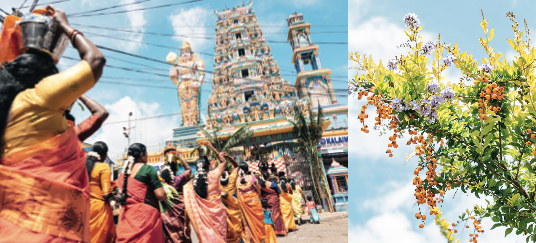
Suresh Sathyanathan’s patio opens out on to Kandapola’s sun- hazed terraces, a wealth of cultivated green broken only by a small landslip, excessive rain collapsing months of toil. The region’s weather has changed swiftly; only a decade ago the village used to pray for rain, but no more. Now heavy downpours clog the soil, and suffocate crops. ‘Something is wrong,’ Suresh states. ’It’s all done by humans: what we give, we get it back. The world is changed.’
Suresh, earnest but rarely seen without a smile, was born in this close-knit neighbourhood. Formerly pickers’ accommodation, Kandapola is fitted so snugly together that its homes form a colourful grotto of pathways and shared stoops. Alongside his wife Priya, Suresh organises Sri Lankan Tamil cooking classes that employ community women who lack income.
Classes take place in Priya’s diminutive kitchen, where neighbour Anuja feeds wood into the hungry fire. This cuisine mixes Sri Lankan and South Indian dishes: today they’re making dosa, idli rice cakes and deep-fried vadai. Made with expensive urad dhal (black gram), vadai are usually served at celebrations. The legumes are soaked for eight hours before salt, onion and curry leaves are added.
Anuja forms deft rings of the dough with greased hands, before dropping the rings in smoking oil. The resulting vadai have crackling shells and indescribably fluffy insides, perfect for chasing coconut chutney about the banana-leaf plate. They’re accompanied by a silky dhal, chewy dosa with beautifully fermented sour notes, and the idyllic flit and twitter of tiny birds.
The sheer terraces mean, for once, tea crops are out of sight. Not out of mind, though, as a tea worker’s meal can have only one conclusion. ‘Yard tea’ is mixed with milk and sugar and aerated by a metre-long drop betwixt pour and cup. It’s warming and wonderful, and it’s impossible not to find homely pleasure in this beloved drink, despite its cruel past and uncertain, unsustainable future. If that sounds like a British sentiment, it’s one that is shared here. ’We only take sugared tea in the mornings,’ Suresh’s cheerful chatter continues. ‘Then we spend the day without sugar. But in the evening I come home and think, “Wow, I need the tea.”’ He pauses and sips, looking out over his slice of sunlit stillness. ‘So I come here, I sit and I drink.’ Food and Travel travelled courtesy of Sri Lanka Tourism Promotion Bureau. srilanka.travel
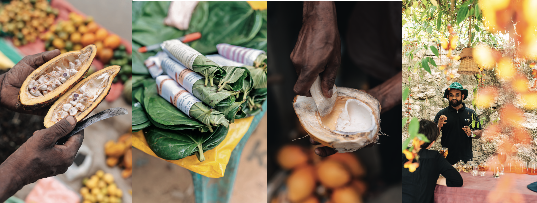
Where to stay
Amba Estate This rolling estate offers an experiential stay with extraordinary scenery, staff and activities. Hike its mountains, go wildlife watching, tour the plantation, join tea and coffee tastings and tuck into traditional meals made by locals. Ensuite doubles from £60, including breakfast. Ambadandegama, Bandarawela, 00 94 57 357 5489, ambaestate.com
Heritance Tea Factory This iconic 19th-century tea factory-turned-eco-friendly hotel sits at 2,000m. Retaining many of its old features, Heritance is steeped in colonial history and quirks. There are multiple restaurants, a stunning bar, spa and myriad experiences, but its sunset views are the ultimate highlight. Doubles from £221, including breakfast. Kandapola, Nuwara Eliya, 00 94 52 222 9600, heritancehotels.com/teafactory
JetWing Warwick Gardens This luxury hotel from Sri Lankan group JetWing is housed within a plantation owner’s elegant manor house, surrounded by its farming community. Rooms are stunning and meals shared around a communal banquet table. There are also locally run refurbished tea picker rooms in the village, catered by former tea picker Meena Amma. Better still, JetWing support sustainable, community-driven tourism. Doubles from £321, including breakfast. Lower Ambewela Division, Ambewela, 00 94 52 353 2284, jetwinghotels.com
Nine Skies Palatial bathrooms, four-poster beds, garden patios and a panoramic infinity pool – plus rambling tropical grounds overlooking Demodera’s valleys, perfect for sunset dinners from their ever-changing fine- dining menu. Garden-view king room for two, including breakfast, lunch and dinner, from £823. Demodera Estate, Demodera, 00 94 77 363 8381, teardrop-hotels.com/nine-skies
Stafford Bungalow Large, detail-oriented and divine rooms, conscientious staff and beautiful gardens overlooked by an infinity pool and hot tub, all topped off by exquisite fine-dining — take afternoon tea or journey through the evening’s glorious tasting menu. Suites from £518, including breakfast and dinner. Ragala, Nuwara Eliya, 00 94 76 137 7659, staffordbungalow.com
Travel Information
Sri Lanka is a South Asian island nation located in the Indian Ocean. It lies to the south-east of India, separated by the Palk Strait and the Gulf of Mannar. The more famous of its two capitals is Colombo, on the west coast, and the country’s Ceylon tea is largely grown around Ella and Nuwara Eliya, south of the mountainous centre. The two official languages are Sinhala and Tamil, although English is widely used. Currency is the Sri Lankan Rupee (LKR), and time is five-and-a-half hours ahead of GMT.
GETTING THERE
Sri Lankan Airlines fly direct from London Heathrow to Colombo, with a journey time of approx. 11hr 25min. From there, hire a car or take a taxi for the 2hr 40min journey to Nuwara Eliya, or take the scenic train option, changing at Kandy. For Ella, continue your drive or take the train again — the stretch between Nuwara Eliya and Ella is one of the most beautiful rail journeys in the world. srilankan.com seatreservation.railway.gov.lk
RESOURCES
Sri Lanka Tourism is the official tourist board. Its website is full of helpful information to help you plan your trip. srilanka.travel
Where to eat
Kesel Kole This quiet roadside buffet just outside Ella is frequented by locals. Overlooking a valley of elephant palms, the views are as good as the home-cooked curries, which change with the day’s market. Buffet from £2. Wellawaya-Ella-Kumbalwela Highway, Ella, 00 94 77 209 3673
Meena Amma Tea Experience If staying at JetWing (see Where to stay), make sure to experience Meena Amma’s simple, locally sourced meals. A favourite of locals in the village, the former tea picker does the best roti in the region. Lower Ambewela Division, Ambewela, 00 94 112 345700, jetwinghotels.com
Rainbow Cafe Open-deck dining and a broad, fusion menu. Try their baby jack burger and a cocktail or two featuring homemade bitters and liqueurs. Alternatively, browse the equally brilliant organic tea menu, which is sourced from a Colombo businesswoman supporting local communities. Lunch with cocktail from £7. 41 Bandarawela Road, Ella, 00 94 77 370 9653, rainbowcafeella.com
Wineetha’s Cooking School The best food in Sri Lanka comes from home: learn how to cook with Wineetha and serve yourself a feast based on the fresh vegetables and fruits that come straight from her garden. Note, you will need a translator or guide. Bandarawela Road, Makulella, 00 94 775 566713
Food Glossary
- King Coconut
- A giant yellow variety found all over the country and considered to have the finest flavour. Pick one up as a refreshing drink from a king coconut stall
- Pandan
- A fragrant plant with a strong floral flavour – the paste is used to dye sweets bright green
- Rice and curry
- Sri Lanka's main dish, usually made up of multiple curries of meat, fish, vegetable, and lentil dahl
- Sambol
- A spicy side, like a condiment, that can be made from a wide variety of ingredients
- Vadai
- A fried dumpling or fritter made with legumes or potatoes
- Yard tea
- Milky and sugary tea that's poured from a height to aerate it
Get Premium access to all the latest content online
Subscribe and view full print editions online... Subscribe

